The Beautiful Immune System Lesson 1: The Two Types of Immunity: Innate and Adaptive
We classify all of the body’s immune reactions into two types of immunity: innate and adaptive. Under each category are many players and thousands of complex systems. Right now, I just want to focus on these two categories.
Our body’s first line of response to an attack comes from the innate immune system (sometimes called the “natural” or “native” immune system. This system begins working against invaders immediately and up to about 12 hours into an invasion by a microbe. Often times, it’s even working before a microbe even comes into contact with the body.
The innate immune system involves all of our outer coverings: our skin, hair, and pores, for example. And it also involves our inner coverings, the lining of our respiratory tract, the lining of our gastrointestinal tract, the lining of the urinary tract–anything that has contact with the outside world. Pretty much any place that is meant to keep things from the outside environment from getting into the very insides of our bodies is at play here.
Once a microbe has decided to attack the body, the innate immune system has some serious jobs to perform. First, it needs to recognize this microbe as something that is foreign to the body. It begins it’s recognition through the use of some receptors on the surfaces of the cells on the body’s physical barriers.
It can’t tell the body what specific microbe is about to attack, but it will clue the body into what class the microbe fits into. For example, the innate immune system would not be able to warn the body of an imminent e. coli attack in the gastrointestinal tract, however it would be able to signal that there is a gram negative bacteria invading. This signal is still important to the body because it tells the body that it is going to need to get ready for attack. The signal is sent right to the adaptive immune system, which we will get to in a moment.
The second job it will perform is that it will begin attack on the invading microbe, if possible, with some of its simple microbe “eating” and microbe killing cells. I will discuss each of these cells in further detail in later posts, but here’s the gist:
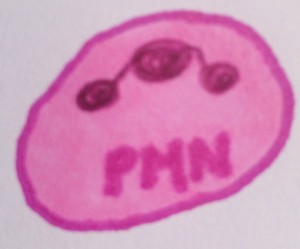
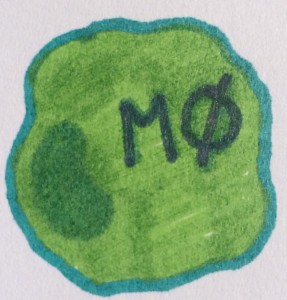
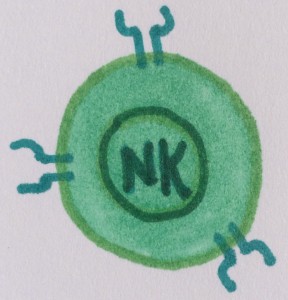
Neutrophils (Shorthand: PMN for polymorphonuclear leukocyte)–Identifies, ingests (phagocytizes), and destroys microbes
Macrophages (Phagocytes) (Shorthand: Mφ)–IIdentifies, ingests (phagocytizes), and destroys microbes
Natural Killer Cells (Shorthand: NK)–Recognizes infected cells and tumor cells and destroys them directly

Dendritic Cells (Shorthand: DC’s)–Secretes chemicals that signal the adaptive immune system
(The shorthand notations are common abbreviations for these cells that you may see in scientific diagrams and notations, including mine.)
Physical barriers, the cells above, and some blood proteins, as well as proteins called cytokines, which regulate and help coordinate many of the activities of the cells that are part of the innate system, are the essential players in the innate immune system.
Once the innate system has responded and started the war, it signals the adaptive immune system to start fighting. In contrast to the innate system, the adaptive system is able to adapt to the infection and form a response. It also is able to remember a microbe and increase in magnitude and its defensive abilities with each exposure to the same microbe. The innate immune system is not able to do this (the innate response dose not “remember”). The adaptive immune system is able to “remember” specific microbes, and for this reason it is sometimes called the “specific immunity”.
The main players in the adaptive immune response are lymphocytes and the products that they create. The two lymphocytes are the B lymphocytes (B cells) and the T Lymphocytes (T cells).
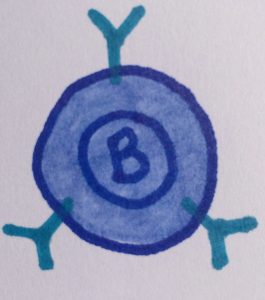
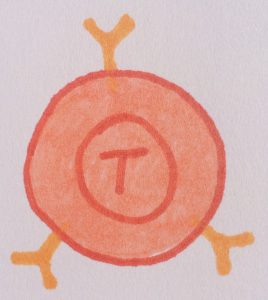
There are also two types of adaptive immune responses: humoral immunity and cell-mediated immunity.
Humoral immunity refers to the products secreted by the blood, as well as the products secreted by the B cells: antibodies. Antibodies are responsible for recognizing microbes and targeting them for elimination. These antibodies are specialized and remember particular microbes due to prior infection with the microbe. The body must first be exposed to the microbe to make antibodies to it.
Cell-mediated immunity begins with the T cells. If the microbe is in a place where antibodies cannot reach it, such as inside of one of the body’s own cells, the T cell signals cells such as macrophages to go in and kill those microbes. T cells are also able to become killer cells, themselves, and perform necessary microbe-killing activities.
If you’re feeling like you are missing some parts of the story here, it’s because you are. All of these processes involve many, many other players in the body, and of course, lots of steps along the line to successfully kill or “jail” the microbe. But don’t you fear; there’s lots more to learn…
Resources:
- Abbas, Abul K., Andrew H. Lichtman, and Shiv Pillai. Cellular and Molecular Immunology. Philadelphia: Saunders Elsevier, Inc., 2010.
6 thoughts on “The Beautiful Immune System Lesson 1: The Two Types of Immunity: Innate and Adaptive”
Comments are closed.


Love it! Thanks for reading! 🙂
I’m so fascinated by the cells and their jobs. My doctor suggested your site because I’m such a virus and immunization freak 😛
Yes, that’s right!
There is an error in the information above – NK cells do not recognize microbes and destroy them directly. NK cells recognize altered self and destroy altered self cells. A classic example would be a self cell that has been infected with a virus.
Thanks! Sometimes I don’t catch those mistakes!
“eminent” e. coli attack = “imminent”
The second job it will preform is = “perform”
Never trust your spell checker!